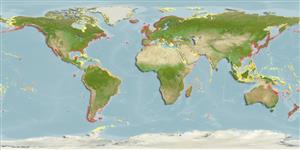Owenia fusiformis delle Chiaje, 1841
Tubeworm| Native range | All suitable habitat | Point map | Year 2050 |

|
| This map was computer-generated and has not yet been reviewed. |
| Owenia fusiformis AquaMaps Data sources: GBIF OBIS |
Изображение на Google |
No photo available for this species.
Классификация / Names народные названия | синонимы | CoL | ITIS | WoRMS
Polychaeta | Canalipalpata | Oweniidae
Environment: milieu / climate zone / пределы глубины / distribution range экология
; солоноватоводный; пределы глубины 3 - 237 m (ссылка 112705). Tropical
Distribution страны | регионы FAO | Ecosystems | места находок | интродукции
Indo-West Pacific, Atlantic Ocean, Arctic and the Mediterranean.
Length at first maturity / Size / Weight / Возраст
половая зрелость: Lm ? range ? - ? cm Max length : 10.0 cm TL самец/пол неопределен; (ссылка 7882)
Life cycle and mating behavior половая зрелость | размножение | нерест | Eggs | Fecundity | Larvae
Основная ссылка
ссылки | координатор | соавторы
López-Jamar, E., G. González and J. Mejuto 1986 Temporal changes of community structure and biomass in two subtidal macroinfaunal assemblages in La Coruña bay, NW Spain. Hydrobiologia 142:137-150. (ссылка 2778)
Статус Красного Списка МСОП
(ссылка 130435: Version 2025-1)
Статус СИТЕС (ссылка 108899)
CMS (ссылка 116361)
Угроза для людей
Использование человеком
| FishSource |
инструменты
дополнительная информация
ресурсы в Интернет
BHL | BOLD Systems | CISTI | DiscoverLife | FAO(Publication : search) | Fishipedia | GenBank (Геном, Нуклеотид) | GloBI | Gomexsi | Google Books | Google Scholar | Google | PubMed | Tree of Life | Wikipedia (Вперёд, поиск) | Zoological Record


